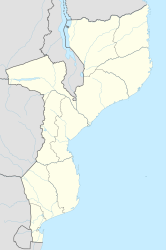Zumbo
| Zumbo | ||
|---|---|---|
|
|
||
| Coordinates | 15 ° 38 ′ S , 30 ° 24 ′ E | |
| Basic data | ||
| Country | Mozambique | |
| Tete | ||
| District | Zumbo | |
| ISO 3166-2 | MZ-T | |
| Residents | 33,000 | |
Zumbo (also Vila do Zumbo ) is a Mozambican border town to Zambia and Zimbabwe .
geography
Zumbo is 347 m above sea level at the mouth of the Luangwa and the Zambezi . On the opposite bank of the Zambezi in Zimbabwe is Kanyemba , on the opposite bank of the Luangwa is the village of Luangwa in Zambia. Zumbo is the seat of the administration of the district of the same name ( Tete province ).
population
Zumbo has 33,000 inhabitants (2005).
history
Zumbo's history dates back to the Munhumutapa Empire , to which Zumbo is said to have belonged. In the 17th century, the Portuguese founded a trading post for ivory from the Bangweul Marshes , which they traded through Petauke . Indians from Goa played an important role here , making considerable fortunes in mines or as traders. Zumbo experienced a long period of prosperity, also as a tourist and hunting center. Until the treaty of 1890 between Great Britain and Portugal, the city was the economically and politically dominant city far inland. During the Mozambican Civil War , the city was fiercely contested because of its key position at the upper end of the reservoir of the Cahora-Bassa Dam and at the borders, which led to great destruction. The population fled to Zambia and Zimbabwe during this period. When she returned after the war, wildlife was living in the ruins of the houses. The area is heavily contaminated with landmines, although many have now been cleared.
Economy and Infrastructure
Today Zumbo is building on the former tourist tradition. There is a functioning tourist office, as well as several operators for safaris on water and on land as well as hunts.
The possibilities of mining have not been fully explored. Portuguese geologists called the rock here ultra basic dykes . Gold was mined here in the past. Diamonds are suspected. Hard coal is already being mined.
Rice, cassava and beans are grown in the region.
There is increased human smuggling in the district. People are brought to Zimbabwe, from where they try to travel on to the Republic of South Africa . For the way to Zimbabwe they pay 300 US dollars (2005).
In 2006, a study by the Institute of Agricultural Research of Mozambique ranked the Zumbo district among those with high incomes in Mozambique in 2002 and 2003.
The road to Tete has been in poor condition or impassable since the flood in 2001. The route by boat across the reservoir is the safest connection with Tete, unless you want to take the roads via Zambia or Zimbabwe. The Kuza ship runs every two weeks from Songo to the Cahora Bassa Dam and is notoriously overcrowded. Zumbo has a power grid, but it only works when the Kuza has brought diesel. The drinking water supply was still idle in 2006.
